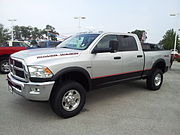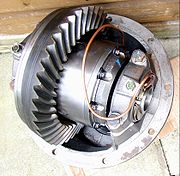- Locking differential
-
A locking differential, diff-lock or locker is a variation on the standard automotive differential. A locking differential may provide increased traction compared to a standard, or "open" differential by restricting each of the two wheels on an axle to the same rotational speed without regard to available traction or differences in resistance seen at each wheel.
A locking differential is designed to overcome the chief limitation of a standard open differential by essentially "locking" both wheels on an axle together as if on a common shaft. This forces both wheels to turn in unison, regardless of the traction (or lack thereof) available to either wheel individually.
When the differential is unlocked (open differential), it allows each wheel to rotate at different speeds (such as when negotiating a turn), thus avoiding tire scuffing. An open (or unlocked) differential always provides the same torque (rotational force) to each of the two wheels, on that axle. So although the wheels can rotate at different speeds, they apply the same rotational force, even if one is entirely stationary, and the other spinning. (Equal torque, unequal rotational speed).
By contrast, a locked differential forces both left and right wheels on the same axle to rotate at the same speed under nearly all circumstances, without regard to tractional differences seen at either wheel. Therefore, each wheel can apply as much rotational force as the traction under it will allow, and the torques on each side-shaft will be unequal. (Unequal torque, equal rotational speeds). Exceptions apply to automatic lockers, discussed below.
A locked differential can provide a significant traction advantage over an open differential, but only when the traction under each wheel differs significantly.
All the above comments apply to central differentials as well as to those in each axle: full-time four-wheel-drive vehicles have three differentials, one in each axle, and a central one between the front and rear axles.
Contents
Types
Automatic lockers
Automatic lockers lock and unlock automatically with no direct input from the driver. Some automatic locking differential designs ensure that engine power is always transmitted to both wheels, regardless of traction conditions, and will "unlock" only when one wheel is required to spin faster than the other during cornering. They will never allow either wheel to spin slower than the differential carrier or axle as a whole, but will permit a wheel to be over-driven faster than the carrier speed. The most common example of this type would be the famous "Detroit Locker," also known as the "Detroit No-Spin," which replaces the entire differential carrier assembly. Others, sometimes referred to as "lunchbox lockers," employ the stock differential carrier and replace only the internal spider gears and shafts with interlocking plates. Both types of automatic lockers will allow for a degree of differential wheel speed while turning corners in conditions of equal traction, but will otherwise lock both axle shafts together when traction conditions demand it.
- Pros: Automatic action, no driver interaction necessary, no stopping for (dis-) engagement necessary
- Cons: Increased tire wear and noticeable impact on driving behavior. During cornering, the automatic locker is characterized by heavy understeer which transitions instantly to power oversteer when traction is exceeded.
Some other automatic lockers operate as an open differential until wheelspin is encountered and then they lockup. This style generally uses an internal governor to sense a difference in wheel speeds. An example of this would be GM's "Gov-Lok."
Some other automatic lockers operate as an open differential until high torque is applied and then they lockup. This style generally uses internal gears systems with very high friction. An example of this would be ZF "sliding pins and cams" available for use in early VWs.
Selectable locker
Selectable lockers allow the driver to lock and unlock the differential at will from the driver's seat. This can be accomplished many ways.
- Compressed air (pneumatics).
- Cable operated mechanism as is employed on the "Ox Locker."
- Electronic solenoids and (electromagnetics) like Eaton's "ELocker." However, OEMs are beginning to offer electronic lockers as well. Nissan Corporations electric locker found as optional equipment on the Frontier (Navarra) & Xterra. 2011 Ford Super Duty F-250 and SRW F-350 4x4 models have a electronic locker as 390.00 USD option. [1]
- Pros: Allows the differential to perform as an "open" differential for improved driveability, maneuverability, provides full locking capability when it is desirable or needed
- Cons: Mechanically complex with more parts to fail. Some lockers require vehicle to stop for engagement. Needs human interaction and forward-thinking regarding upcoming terrain. Unskilled drivers often put massive stress on driveline components when leaving the differential in locked operation on terrain not requiring a locker.
Dodge Power Wagons feature front & rear selectable locking differentialsARB Air locking differential fitted to a Mitsubishi Delica L400 LWB DiffSpool
The internal spider gears of an open differential may also be welded together to create a locked axle; however, this method is not recommended as the welding process seriously compromises the metallurgical composition of the welded components, and can lead to failure of the unit under stress. If it is desirable to have a spooled axle, the better option is to install either a mini-spool, which uses the stock carrier and replaces only the internal components of the differential, similar in installation to the lunchbox locker, or a full spool which replaces the entire carrier assembly with a single machined piece. A full spool is perhaps the strongest means of locking an axle, but has no ability to differentiate wheel speeds whatsoever, putting high stress on all affected driveline components.
Disadvantages
Because they do not operate as smoothly as standard differentials, automatic locking differentials are often responsible for increased tire wear. Some older automatic locking differentials are known for making a clicking or banging noise when locking and unlocking as the vehicle negotiates turns. This is annoying to many drivers. Also, automatic locking differentials will affect the ability of a vehicle to steer, particularly if a locker is located in the front axle. Aside from tire scuffing while turning any degree on high friction (low slip) surfaces, locked axles provoke understeer and, if used on the front axle, will increase steering forces required to turn the vehicle. Furthermore, automatically locking differentials can cause a loss of control on ice where an open differential would allow one wheel to spin and the other to hold, while not transferring power. The disadvantages of selectable locking differentials are not mentioned due to the ability to function as an open differential as needed.
Alternatives
Limited slip differentials are considered a compromise between a standard differential and a locking differential because they operate more smoothly, and they do direct some extra torque to the wheel with the most traction compared to a standard differential, but they are not capable of 100% lockup.
Traction control systems are also used in many modern vehicles either in addition or as a replacement of locking differentials. One example is that offered by Volkswagen under the name of electronic differential lock (EDL). This EDL is not in fact a differential lock, but operates at each wheel. Sensors monitor wheel speeds, and if one is rotating more than 100 RPM more than the other (i.e. slipping) the EDL system momentarily brakes it. This effectively transfers all the power to the other wheel,[2] but still employs the open differential, which is the same as on cars without the EDL option. Electronic traction control systems may be integrated with anti-lock braking systems, which have a similar action on braking and use some similar components. Such systems are used for example on the most recent Nissan Pathfinder, Land Rover Defender and Land Rover Freelander models.Applications
- Race cars often use locking differentials in order to maintain traction during high speed maneuvers or when accelerating at extreme rates.
- Some utility vehicles such as tow trucks, forklifts, tractors, and heavy equipment use locking differentials to maintain traction, especially when driving on soft, muddy, or uneven surfaces. Lockers are common in agricultural equipment and military trucks. On some farm tractors, there is a pedal that can be stepped on with the operator's heel to lock the differential as needed.
- Four-wheel drive vehicles that drive off-road often use locking differentials to prevent from getting stuck when driving on loose, muddy, or rocky terrain. Locking differentials are considered essential equipment for serious off-road driving. Many such vehicles have a locking differential on the central differential (between the front and rear axles), locking rear differential and locking front differential; or any combination of any of the three.
- Differential locks are also used on some non-utility four-wheel-drive vehicles (such as the Mitsubishi Shogun) to compensate for a relative lack of axle articulation (vertical wheel movement). High amounts of articulation are desirable for off-road driving, to allow the wheels to maintain ground contact over uneven surfaces, but this can lead to excessive body-roll at high speeds on the road, as well as vague steering. Such 4x4s often have suspension systems designed as a compromise between articulation and handling. If articulation is limited, one wheel on an axle may be lifted off the ground by rough terrain, thus losing all traction to all wheels (all power goes to the lifted wheel, which spins freely). A rear locking differential is often supplied to make up for this compromise – if a wheel is lifted off the ground, the locking differential can be brought into play, driving the wheel that remains on the ground.
- Differential locking can also be used in the sport of drifting as an alternative to a limited slip differential.
References
- ^ http://blogs.fourwheeler.com/6564589/whats-new/2011-ford-super-duty-electric-locker-lowdown/index.html
- ^ "VAG four-wheel drive systems and brand names". http://briskoda.net/technical-guides/vag-four-wheel-drive-systems-brand-names/2584/.
See also
Categories:- Automotive transmission technologies
Wikimedia Foundation. 2010.


